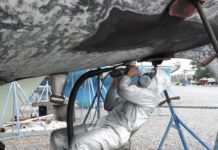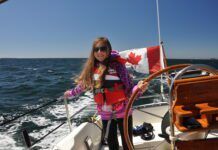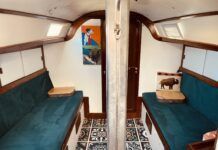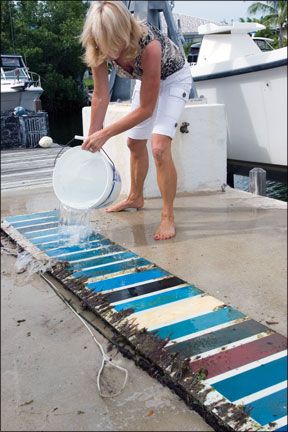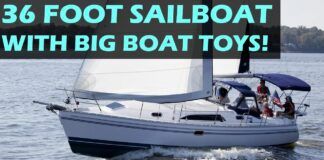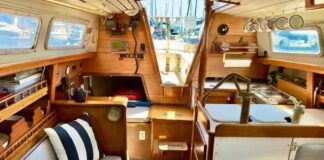This update to our continuous bottom paint test takes a look at four sets of paint panels from two locations (Long Island Sound and a south Florida saltwater canal). One set was dunked in 2006, and the other in 2005.
The paints run the gamut as far as type&emdash;from hard antifouling coatings to ablative to white and bright to those with anti-slime additives. Products from the top brands were included&emdash;Interlux (http://www.yachtpaint.com/), E Paint (http://www.epaint.net/), Pettit (http://www.pettitpaint.com/), Sea Hawk (http://www.seahawkpaints.com/) , Flexdel (http://www.aquagard-boatpaint.com/) , and Blue Water Paints (http://www.aquagard-boatpaint.com/) &emdash;as were the top performers from our past tests, including Micron Optima. For the average northern sailor, who hauls out each winter, we would recommend buying the cheapest of our recommended paints that fits your preferences (water based, eco-friendly, whatever), and rates well among local sailors and paint pros. Any one of these paints will get you through the season without barnacles.
****
Picking the right bottom paint is as much a matter of matching the right paint for the job, as it is picking the most effective, or longest-lasting paint. Choices abound: hard paint or soft paint, bright-colored paint, eco-friendly, copper-free paint, and even water-based paint, all with prices ranging from a relatively cheap $60 a gallon to lofty numbers over $200 a gallon. We endeavor here to help you find the right paint for your boat at the right price.
This time around, our biannual review of bottom paints includes a few money-saving reports. On pages 10-11, youll find a 12-month update on test panels that have been immersed since June 2006. On pages 12-13, youll find the final two-year report on panels that were immersed in June 2005.
As weve done for the past several years, we first divided the one-year paints into hard- and soft-paint categories. Hard paints can be very potent and resist scrubbing, but many can lose their effectiveness after hauling out. One downside to hard paints is the multi-layered buildup created after several years of reapplication. At some point, the paint starts to crack and chip, and it is best to strip off all the hard paint buildup and start fresh.
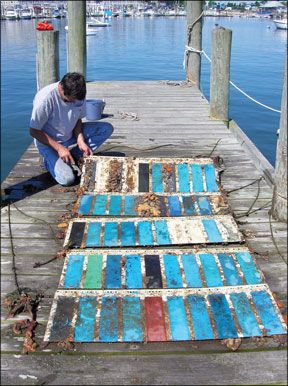
Soft paints, better known as ablative paints, wear away over time. There are essentially two kinds of ablative paints, sloughing paints, which physically wear away to expose fresh biocide, and “self-polishing” copolymer paints, which chemically control the release of biocides over time. Usually a quick pressure wash, and youre ready for your next coat of paint. Minimal prep work is needed.
Either hard and soft paints can offer excellent protection, and within each type are various sub groups. For the best results, pick a paint that suits your particular circumstances. Thats where this report comes in.
How We Tested
Our test procedure and protocol is essentially the same as it has been for the last several years. Testers start with brand-new polyester/fiberglass panels, wash them with a de-waxing solvent to remove any wax or mold-release agent, sand them lightly with fine-grit sandpaper to take the sheen off the glass, and then wash them again with solvent to wipe the surface clean. Each panel is then taped into 10 sections to create a border of unpainted surface between each paint. This sectioning and the way the panels are hung closely simulates paint near the waterline on the side of the hull.
The number of coats and method of application is completed according to the manufacturers instructions. Individual panels are identified by a simple binary code drilled into the panel with a series of holes. When we pull the panels, paints are rated with no reference to the name or manufacturer.
All paints were tested in two locales. One set was dropped into a saltwater canal in the Florida Keys (Tavernier, Fla.), the other tied to the docks at a boat yard in eastern Long Island Sound (Groton, Conn.). At any given time, we have two sets of panels at each location. For this review, all the panels were pulled and rated in late June or early July 2007. A new set of panels, installed to replace the two-year-old paints, will be reported on in the February 2008 issue.
Before assigning ratings, testers sluiced the panels with buckets of seawater. The Excellent rating is given to paints that show virtually no growth. This is an absolute rating and does not vary from test to test. Good and Fair ratings are relative to the field and can vary from rating session to rating session, based on the overall condition of the paints being reviewed. Good ratings go to those paints with a minimum of soft growth while coatings with Fair ratings have clearly allowed more soft growth to occur. Poor ratings are given to panels with hard growth. Again the Poor rating is absolute.
Once we have the ratings on paper, editors identify overall winners, as well as the top paints in the various categories, such as ablative, hard, environmentally-friendly, and water-based paints. Most of the Recommended paints scored Good in both locations or a combination of Excellent and Fair. If some similar paints scored equally in both locales, we gave the nod to the lower-priced product.
It should be noted that our panel tests are but one data point, to be used with other information gathered at your locale, either from your own experience, local boatyards, or fellow sailors. Even among our panels, performance in the same location can vary from year to year. Paint performance can be affected by a number of factors, including average water temperatures, current flow, tide height, and the number and variety of marine organisms in the seawater.
Paints After One Year
Nearly all the paints on our one-year-old panels offer outstanding protection for 12 months against the formation of any speed-robbing hard growth on a boats bottom. Its the details of price, soft-growth protection, and environmental impact that testers use to pick the best in this group.

Self-polishing paints now make up the majority of our test field&emdash;37 ablative to 28 hard. As a group, the ablative category scores better than the hard paints, with a higher percentage of Recommended paints, as well as the two Best Choice paints after one year. This trend was also evident at the one-year mark last year. (Interestingly, the ablatives tend to fall behind the hard paints past the 18-month mark, but this could be attributed to the lack of water flow across the test panels surface.)
Another continuing trend weve noted is the addition of an anti-slime agent to a copper paint to enhance soft-growth protection or the stand-alone use of one of these agents as the primary growth inhibitor. This year, like last year, about half the paints on our list use an anti-slime agent.
While copper-based paints with the anti-slime additive Irgarol have produced mixed results in our tests, those with zinc-based anti-slime agents combined with copper have been doing very well. However, when either of these agents are used without copper (Irgarol-only paints are marketed only as freshwater paints), the results have been less than stellar.
In the eco-friendly arena, weve seen several copper-free paints that are capable of achieving a Fair rating, but none that can consistently produce results close to the copper paints. All this comes at a relatively high price, too, with the best copper-free paints designed for saltwater usage costing at least $125 a gallon and most of the others costing much more.
The number of paints available in bright colors or white continues to rise. Last year, we put seven whites on our test panel, and this year, nine. Most bottom paints are available in three or four standard colors, usually black, blue, green, and maybe red. The trend toward brighter colors in more shades including white, is accelerating with Pettit Vivid, Interlux Trilux paints, Epaints, the Sea Hawk Mission Bay series, and Blue Water Kolor. Numerous other paints are available in bright colors but not white.
After one year in the water, Micron Optima was clearly the cleanest panel in both locations and so retains the Best Choice rating. This rating comes with an important caveat noted in our conclusion. Sea Hawk Biocop TF, a Best Choice at the six-month, performed well and is still a Recommended paint. A pair of Blue Water paints earned our Budget Buy honors. Sea Bowld Coastal 45 was our pick for a hard paint with Sea Bowld Ablative 56 besting the group of soft.
Rookie Redux
The one-year panels gave us our second look at several paints that were new to our tests. The most notable were the environmentally-friendly copper-free and tin-free paints from Sea Hawk and Pettit. Because these paints contain no copper or tin, they are safe for use on fiberglass, aluminum, wood, and steel-hull boats.
Results for Sea Hawks Mission Bay and Mission Bay CSF were mixed. Mission Bay CSF dropped all the way to Poor at the one-year mark in Florida. On the other hand, in the cooler waters up north, this pair did well with median ratings of Good. Being a friend of the marine environment doesn’t come cheap: These two paints are some of the most expensive tested and cost upward of $200 a gallon.
Pettits new entry in the eco-friendly field, Alumacoat SR, managed across-the-board Fair ratings in Florida and Connecticut.
The field includes two economy ablative paints that hadnt been tested before, Interlux Epoxycop Ablative and Blue Water Copper Shield 45 Uno, both less than $90 a gallon and both mustering mostly Fair ratings.
The best new paint was Sea Hawk Biocop TF, a “semi-hard” self-polishing copolymer paint for multi-season use which also rated well at the six-month mark. The only downside on this paint is price: At more than $225 a gallon, it is the most expensive paint tested.
Four new hard paints hit the water last year. Three paints from Blue Water did rather well at the one-year mark. The two economy paints, Copper Shield 45 Hard and MarPro Superkote Hard, both priced under $90 a gallon, had Good ratings in one or both locations. MarPro Superkote Gold, a mid-priced paint, earned both Good and Fair ratings, too.
Sea Hawk also had a new hard, modified-epoxy participant: Sharkskin. This single-season paint earned Fair ratings in Florida and a Good in Connecticut.
Conclusions
The panel with the best combined ratings after one year was Interlux Micron Optima, our Best Choice. This $202-per gallon ablative/copolymer garnered Excellent ratings in both Florida and Connecticut. Again, keep in mind this is a two-part paint, complicating application, but this is partially offset by the fact that it is water-based, which simplifies clean up. Does everyone need Optima? Of course not. For the average northern sailor, who hauls out each winter, we would recommend buying the cheapest of our recommended paints that fits your preferences (water based, eco-friendly, whatever), is compatible with your existing coating, and rates well among local sailors and paint pros. Any one of these paints will get you through the season without barnacles, but you might have to scrub to stay slime free. If youre willing to pay more to minimize scrubbing, or if you hope to sail year round in warm waters, then the two-year paints described on page 13-14 also deserve consideration. We do have Optima on two of our test boats, so we will be reporting on its performance (along with others) in actual use next issue.
Our Budget Buy in the ablative/copolymer category remains Sea Bowld Ablative 56, which scored Good ratings across the board in both locations. Recommended paints in ablative category were Blue Water Kolor, Interlux Bottomkote, Interlux Micron 66, Interlux TriLux II, Pettit Ultima SR, West Marine PCA Gold, Sea Hawk Biocop TF, West Marine CPP, and Sea Hawk Monterey. All earned Good or better for their one-year ratings in both Connecticut and Florida.
Our top hard paint, with a Good in Florida and an Excellent in Connecticut was Pettit Vivid. Other recommended hard paints were MarPro Superkote Hard, and West Marine Bottom Pro Gold. Sea Bowld Coastal 45 by Blue Water was our Budget Buy hard paint.
With two Good ratings for the year and a price of $95 per gallon, Flexdel Aquagard earned our pick for a water-based paint.
For bright color or white paint, we tapped Blue Water Kolor with across-the-board Good ratings for the year and Pettit Vivid, which averaged a Good rating for the year.
For painting aluminum or for a copper-free coating, we choose Epaint EP-21. It is by far the least expensive eco-friendly coating, and it was able to maintain across-the-board Fair ratings in both locales.


















